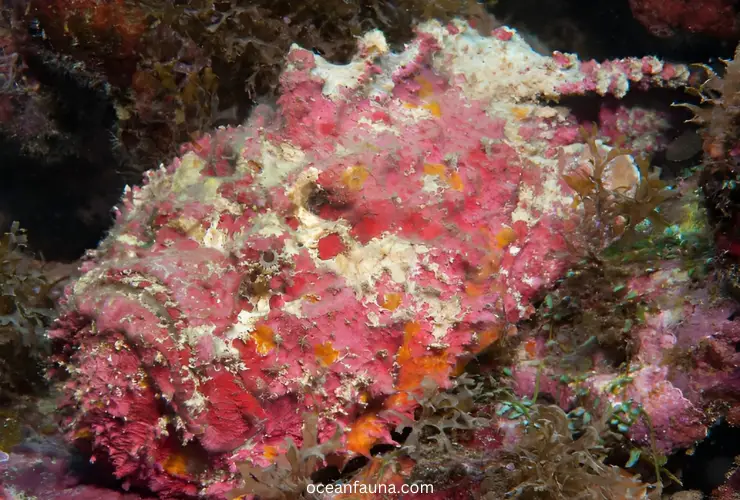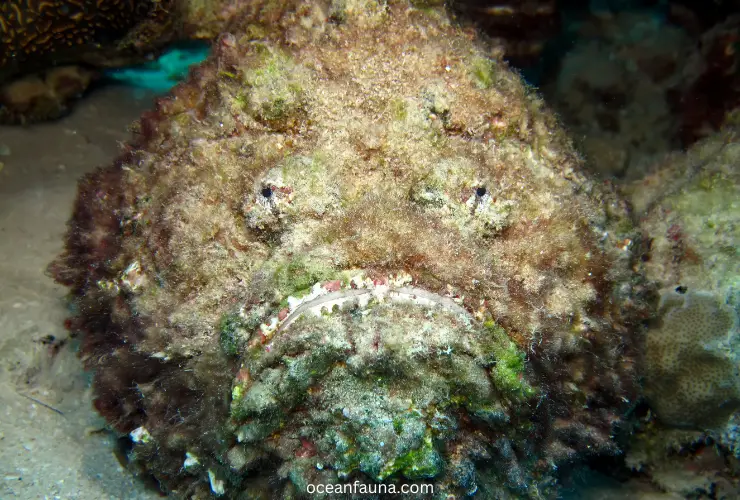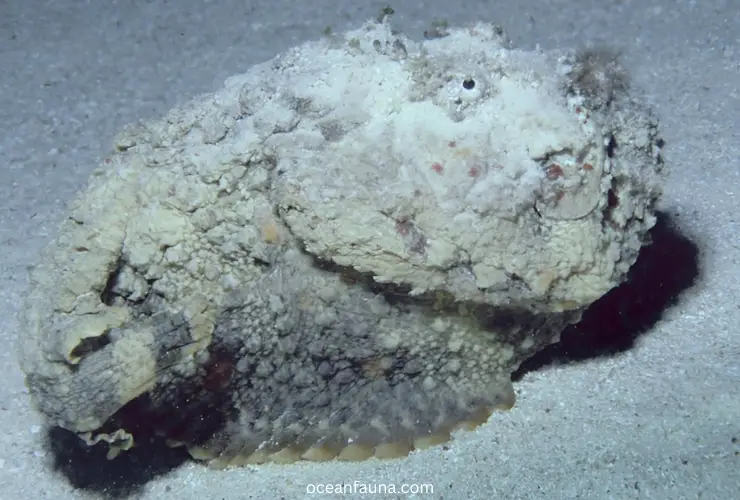Did you know that there’s a fish out there that can expertly camouflage itself and blend into the surroundings?
Meet the reef stonefish! It is a remarkable creature that has beautifully adapted to its environment. It is the world’s most venomous fish. It also listed its name as that of a deadly predator inhabiting the Indo-Pacific region’s tropical waters.
With its rough and bumpy skin without scales, the reef stonefish can blend seamlessly into its surroundings. This makes it almost impossible for its prey or potential predators to spot it. It has fleshy fins that help it quickly move around through the coral reef and over rocky surfaces.
The reef stonefish is also equipped with venomous spines on its dorsal fin, which it can use to defend itself against predators or stun and kill its prey. The venom is so potent that it can cause severe pain, paralysis, and even death in humans.
But despite its dangerous reputation, the reef stonefish is a fascinating creature with many exciting adaptations and behaviors. Are you curious to know more about this elusive fish? Keep reading to uncover the secrets of the reef stonefish.
About Reef Stonefish – A Quick Biology
Let’s take a quick look at this captivating species.
| Parameters | Details |
| Scientific name | Synanceia verrucosa |
| Kingdom | Animalia |
| Family | Synanceiidae |
| Genus | Synanceia |
| Phylum | Chordata |
| Class | Actinopterygii |
| Order | Perciformes |
| Species | S. Verrucosa |
| Habitat | Shallow coastal waters |
| Life Span | 5-10 years |
| Diet | Carnivores |
| Geography | Indo-Pacific region, including the Red Sea, East Africa, Australia, and Japan. |

Description And Geographic Distribution of Reef Stonefish
Reef stonefish can be found in various locations. Most significantly, you will find them in the Indian and western Pacific oceans. These fish are prevalent in the following regions:
- India
- Papua New Guinea
- Japan and
- Australia.
Certain types of stonefish are also present in the Red Sea and along the East African coasts. In the Mediterranean, people have reported sightings of stonefish.
According to recent research published in Marine Drugs,
The Synanceia verrucosa species are found in the following territories:
- Turkey
- Mozambique
- Sri Lanka
- Singapore
- Japan
- Australia, and
- Throughout the islands of the Pacific Ocean, including French Polynesia.
Another study published in SN Comprehensive Clinical Medicine indicates that reef stonefish are primarily concentrated in the coastal waters of the Indo-Pacific region, which encompasses the USA, Australia, Malaysia, Hong Kong, and Singapore.
Appearance of Reef Stonefish
A recent study published in “SN Comprehensive Clinical Medicine” has revealed some interesting physical characteristics of reef stonefish. The study found that these fish have warty and scaleless skin. They are typically brown or gray, with patches of orange, red, or yellow, and sometimes even covered in algae.
However, the most noticeable feature of the reef stonefish is its long dorsal spines. The dorsal fin of this fish contains about 12 to 14 spines that are uniform in length and 5 to 7 soft rays, all of which have venomous glands at their bases.
They have giant, upturned mouths and small eyes high on their heads. Each eye is accompanied by a deep pit located behind it. These fish can grow up to 24 inches, although the average size typically ranges between 14 and 20 inches.
Moreover, they can weigh up to a maximum of 5 pounds, making them relatively small fish compared to some marine counterparts.
Behavior of Reef Stonefish
According to research at The Aquarium of the Pacific, these fish are usually solitary creatures, except during mating season when they search for a mate. They are masters of disguise and often appear as rocks or pieces of coral on the seafloor.
You could easily swim past them without noticing them! But don’t be fooled by their sneaky ways. They will use their spiky fins to inject venom into the attacker if they feel threatened.
They are primarily active at night, when they hunt for prey. These fishes don’t actively hunt their prey but wait for them to come close before quickly striking and swallowing them. Even though they appear calm and still, they can strike incredibly fast—in less than a second.
Habitat And Range of Reef Stonefish
So, where are these stonefish found? Reef stonefish stay close to the ocean floor for most of their lives. They like to live in warm, shallow waters near coral reefs because it’s an excellent place for them to hide from bigger predators and find food quickly.
They often lie on rocks, plants, or the sandy ocean floor when they rest. The coolest part is that they can blend perfectly with their surroundings and even hide under algae! During low tide, you can find them in small pools too. (Source)
But can they survive on land? The answer is NO. Stonefish cannot survive on land because they are marine creatures. They require water to breathe and maintain bodily functions.
Feeding/Diet—Are Reef Stonefishes Carnivores, Herbivores, Or Omnivores?
Reef stonefish are carnivorous, relying on other animals as their primary food source. Their diet primarily consists of other reef fish and bottom-dwelling invertebrates, such as shrimp and crustaceans.
They are patient hunters and can sit motionless on the reef floor for extended periods, waiting for prey to swim by. Once a potential meal approaches, the stonefish will quickly engulf it using its large mouth and powerful jaws. (Source)
Reproduction System of Reef Stonefish
The reef stonefish has a mating system called promiscuity, which means that the female fish does not choose which male can fertilize her eggs. When a female stonefish gets sexually mature, she lays her gelatinous egg mass while swimming across the seafloor. Males will then follow, releasing their sperm as they swim over the newly laid eggs.
When the eggs hatch, they are already fairly developed. But it takes a long time, about three years, for them to become mature adults. Because of this, only a few reach adulthood, but those who do can live up to 5 to 10 years.
Toxicity of Reef Stonefish
Did you know that stonefish venom is incredibly potent and can be deadly in just a small amount? In fact, the fish can release enough venom to be fatal with just six of its thirteen spines. Depending on the species, the makeup of the toxin can vary. But in reef stonefish, the lethal protein is called verrucotoxin protein.
The venom is especially dangerous to young children, the elderly, and those with weakened immune systems. Still, even healthy individuals can be affected by a large dose. If someone survives a sting, they may experience nerve damage and muscle atrophy in the affected area.
Stonefish venom comprises a combination of different proteins, including stonustoxin, verrucotoxin, and cardioleputin, which can all affect the body differently. (Source)

Predators of Reef Stonefish
You may be wondering who in their right mind would dare to eat these poisonous creatures. But, believe it or not, stonefish have natural predators who can consume them without any ill effects, such as sharks, stingrays, eels, and sea snakes. However, younger stonefish are more susceptible to being preyed upon than their adult counterparts.
Human Uses -Count As Meal Or Threat to Ocean Ecosystem?
What’s even more intriguing is that, despite being one of the deadliest creatures in the world, the stonefish is also a culinary delicacy among humans. This venomous fish is in high demand in Hong Kong markets and is often served in Chinese restaurants worldwide. The Philippines also considers it a delicacy, and locals relish its taste.
It may also surprise you that the stonefish is a popular choice among aquarium enthusiasts across the globe. Despite its fearsome reputation, its unique appearance and captivating behavior fascinate people. No wonder this enigmatic creature has gained immense popularity in and out of the water.
Population of Reef Stonefish
Although stonefish have a low survival rate until adulthood, they are still abundant. They are not heavily fished commercially, contributing to their stable populations.
While the ongoing destruction of coral reefs may impact their populations in the future. There are currently no significant signs of decline in any species. Therefore, the IUCN has classified them as a species of Least Concern.
Can Reef Stonefish Survive Without Water?
Reef stonefish are primarily aquatic animals. Yet, they can stay alive out of water for up to 24 hours by taking in oxygen through their skin, as long as their surrounding environment remains damp. However, they will generally die from suffocation and dehydration after about 24 hours.
Stonefish do not breathe air in the same way that land animals do. As fish, they extract oxygen from the water using their gills. Unlike air-breathing catfish or lungfish, which have evolved lungs to breathe air in addition to gills, stonefish do not have lungs and cannot breathe air.
Are Reef Stonefish Poisonous Or Aggressive?
Reef stonefish are poisonous, but they are not typically aggressive. They are usually docile and only use their venomous spines as a defense mechanism when they feel threatened.
However, baby stonefish can be more dangerous than adult stonefish because their venom is more concentrated. It is important to avoid handling or stepping on stonefish, whether they are adults or babies, as their venom can be extremely painful and potentially deadly.
What happens when you step on a reef stonefish?
If you accidentally step on a stonefish, it will immediately raise its spines and squirt venom from two tiny bags at the base of each spine. People usually get stung by stonefish on their feet while walking on reef flats or rocky areas. Even if your shoes are on, the spines can penetrate them and cause harm. (Source)
Are you curious about what would happen next? How painful is a stonefish sting?
Suppose you are unlucky enough to get stung by a stonefish. In that case, you may experience severe pain, swelling of the skin, and potential tissue damage. The severity of the venom’s effects depends on the amount that enters your body. It can range from mildly painful to life-threatening.
In the worst cases, stonefish stings have been fatal. To put the toxicity of the stonefish’s venom into perspective, consider that only a tiny amount—the size of a grain of salt—is enough to kill half of a population of mice.
Can you survive a stonefish sting without treatment?
Enduring a stonefish sting without treatment is extremely unlikely. Indeed, the venom produced by stonefish is one of the most potent in the world and can even cause death. Even if treated quickly, recovery from a stonefish sting typically requires 24-48 hours.
What should I do if a stonefish bite me?
If you get stung by a stonefish, the first thing you should do is not panic. Panicking won’t help with the pain. In fact, it might make things worse by making your heart beat faster and causing the venom to spread more quickly. Rather, follow the steps outlined below to improve your chances of survival.
- Seek medical attention immediately. Stonefish venom can be fatal, and prompt treatment is crucial. Depending on the severity of the sting, you may have around 15 minutes to half an hour to seek help before things get terrible.
- Pour hot water into the affected area at no more than 113°F (45°C) to weaken the venom’s effects. You can also use vinegar to control and reduce the pain and gain time before getting medical aid.
- DO NOT try to remove any spines left in the wound, as this can cause further harm.
- Keep the affected limb still and below your heart’s level to slow the spread of toxin.
- If possible, apply a pressure immobilization bandage to reduce the spread of venom to other parts of the body.
Note: A stonefish sting can potentially have fatal systemic toxicity effects on humans. Prevention is the best defense against stonefish stings. When swimming or diving, be aware of your surroundings and avoid touching or stepping on any creatures you can’t identify.

Can You Eat Reef Stonefish?
Yes, you can eat reef stonefish, provided they are appropriately prepared. Although they are very deadly, humans can eat stonefish if cooked properly. The protein-based venom breaks down quickly when the fish is cooked, making it safe to eat.
If the fish is served raw as sushi, the toxin can be made harmless by removing the dorsal fins, where most of the poison is located.
People in Asia consider stonefish a treat, especially in the following countries:
- South Japan
- South Fujian
- Guangdong in China, and
- Hong Kong.
In the Hokkien-speaking region, they are believed to be good for your fitness. The flesh of the stonefish is white, thick, and sweet, and even the skin can be eaten. It’s usually cooked with ginger in a clear soup or sometimes served raw as sushi or sashimi.
Has Anyone Survived a Stonefish?
The world’s deadliest stonefish has caused trouble for many people. Around 800 to 1,000 people in Australia get stung by stonefish every year. Sadly, there have been many reported deaths of people living in the Pacific and Indian Oceans near the shores from these stings.
However, one noteworthy incident involves an Australian man named Adam Clancy. He unintentionally stepped on a stonefish and immediately felt unbearable pain. But luckily, he survived.
Although his foot was swollen, red, and blistered, he remained calm and did not panic. He refused painkillers and relied on hot water and red wine to alleviate the pain. Adam returned to work the next day but had to limp on his stinging foot for three weeks.
Despite his experience, Adam does not recommend taking the sting lightly. He urges others to seek medical attention if they encounter a stonefish.
FAQs
Do stonefish still exist?
Yes, stonefish still exist. In fact, there are quite a few recent cases of stonefish stings. For instance, in 2020, The Guardian published an article about a man stung by a stonefish while swimming. This incident happened in the sea off the coast of Queensland, Australia.
Can you touch stone fish?
As a rule, you should avoid touching aquatic creatures, particularly the stonefish, the most venomous fish in the sea. Stonefish are covered in prickly spines that carry toxic venom. They do not strike humans but can inflict hurting stings by releasing powerful toxins when touched or stepped upon unintentionally.
Can stonefish change colors?
Yes, stonefish can change their color for camouflage purposes. They can blend into their environment by changing their color. They can even change their shape to look like a stone and appear as part of a stone or coral wall. This helps them avoid predators and prey alike.
Are freshwater stonefish poisonous?
While various fish species are commonly known as “freshwater stonefish,” none are actually ‘true’ stonefish. The term “stonefish” is typically used to describe a collection of venomous fish that inhabit saltwater environments, primarily in the Indo-Pacific area.
What do baby stonefish eat?
The larvae of stonefish initially feed on plankton until they develop into juveniles. As juveniles, they may feed on small shrimp, crabs, and other small invertebrates.
Do Japanese eat stonefish?
Yes, stonefish is considered a delicacy in some parts of Japan and is known as “okoze” in Japanese cuisine. The preparation typically involves removing the spines and boiling the fish for several hours to denature the venom.
Can octopuses eat stonefish?
Yes, octopuses are known to eat stonefish. In fact, octopuses are one of the few predators that can safely consume stonefish due to their immunity to the fish’s venom. Octopuses are highly skilled hunters and can use their powerful beaks to crush the stonefish’s spiny exterior and consume the flesh inside.
Conclusion
The reef stonefish is a fascinating and deadly creature with remarkable adaptations and behaviors that allow it to survive in its environment. Its ability to blend seamlessly with its surroundings. This speciality makes it a formidable predator and master of camouflage, often mistaken for harmless rocks. However, stepping on them can activate their venom glands, making them an exceptionally dangerous threat.
But wait, there’s more to these enigmatic creatures! Did you know there is a noticeable size difference between male and female reef stonefish, referred to as sexual dimorphism? Specifically, females tend to be larger than males. Despite their danger, reef stonefish also reminds us of the remarkable diversity and intricacy of life on our planet.

